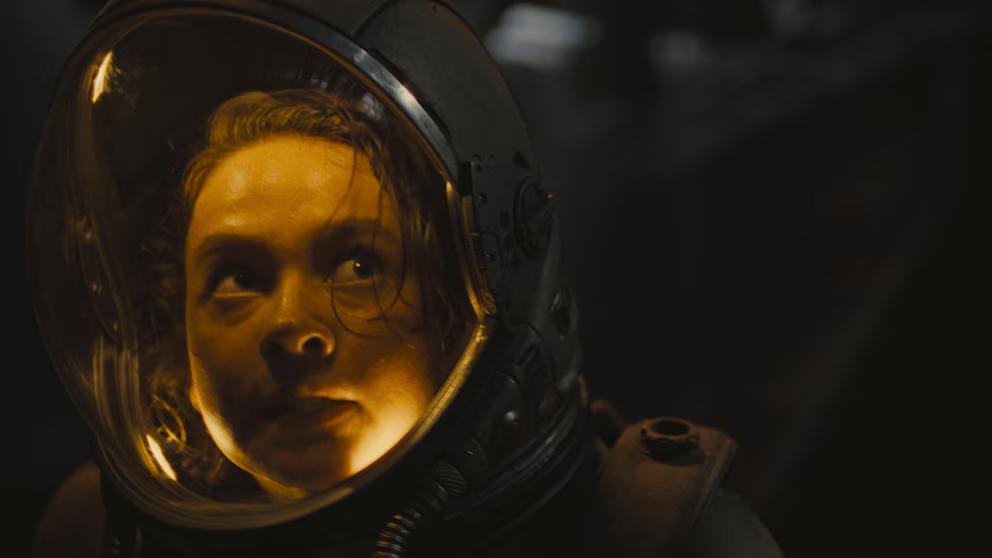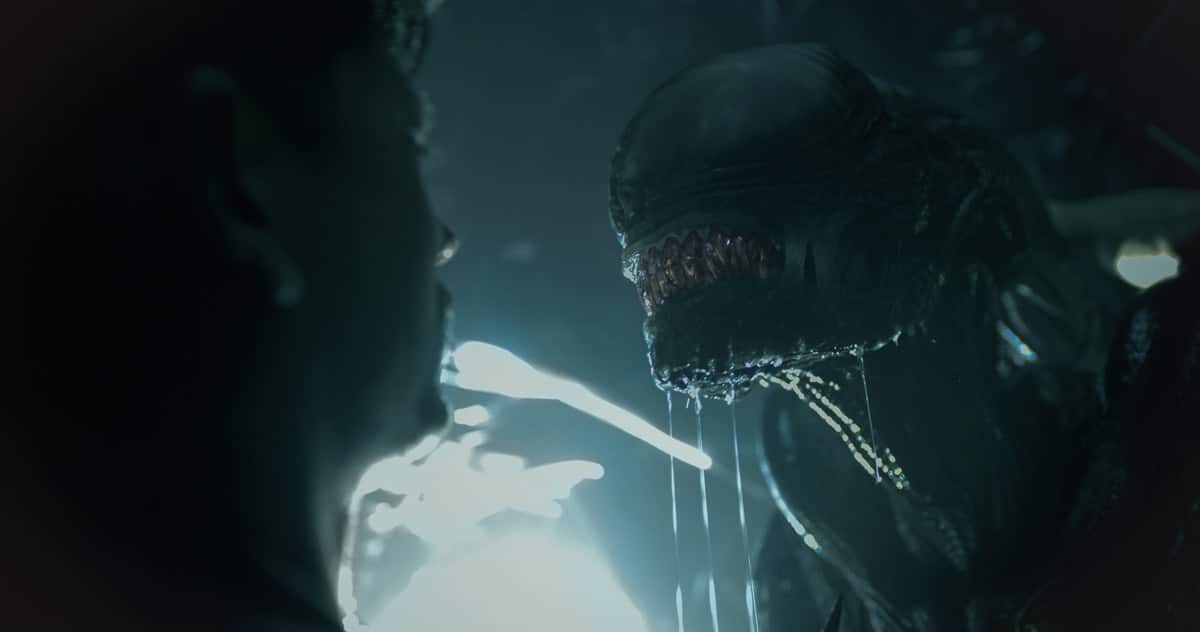
Getting a new Aliens film? Great, but after a few misfires (you can decide which were misfires, but I bet you think there were some) it can feel like a mixed blessing, perhaps. Wars have very nearly been fought over these movies, because the first two instalments set the bar so extraordinarily high; if the xenomorphs are ‘perfect organisms’, then so are the films which introduced us to them. Arguably, there have been diminishing returns since Aliens (1986) and for the remainder of the Ripley story arc, before different writers and directors took us through some offshoots and prequels to the main story.
Alien: Romulus (2024) positions itself between the events of Alien (1979) and Aliens, i.e. between the fate of the Nostromo and then the fate of the colony at Hadley’s Hope, and those sent to investigate. Ripley herself is never named in Romulus; she’s in deep space somewhere, yet to share her knowledge of the singular new organism which is of such interest to the pan-planetary corporation, Weyland-Yutani. Instead, in a mining colony called Jackson’s Star, we meet Rain (played by the very Elite Dangerous-sounding Cailee Spaeny). Rain is a worker, living a thankless life where – thanks to planetary environmental conditions – the sun never shines. She hangs onto the simple dream of seeing a sunrise – but gaining access to a planet where she stands a chance of getting her wish is impossible to come by. The company won’t release her from her contract; in fact, her life is set to get darker and more dangerous, as they want to send her into the mines, a deathtrap of lung damage and disease and an almost certain ticket to an early, sunless grave.
Alongside her ‘brother’ Andy – actually a defective end-of-line synthetic rescued by her late father – she agrees to participate in a scheme hatched by a group of her friends. They have detected an abandoned Weyland vessel, floating in orbit above their heads: if it has hypersleep pods, as they suspect, then they stand a chance of escape, sleeping the nine years it will take to get to a world called Yvaga (meaning ‘paradise’ – heh). To do it, they need Andy: he’s a piece of Weyland tech, and will be able to grant them access through the various security systems and doors. Reluctantly, but desperate to escape the mines which killed her parents, Rain agrees, and Andy agrees because his prime objective is to do what’s best for her. They take off in the small mining vessel they have (somehow) occupied for themselves, finding not just an abandoned ship, but an entire space station, now rolling perilously close to the frozen planetary rings.
Rescuing expensive, complex and company-owned hypersleep technology from a derelict space station before it wrecks itself on these rings is one thing, but there’s an even bigger problem, one which only the audience understands – for now. Just as the opening credits rolled, we saw a team of people picking through the wreckage of the Nostromo, ostensibly for salvage – but they were particularly interested in what looked like a fossilised lifeform, which they excitedly hauled aboard. Uh-oh. So where are those people now? And what exactly might they have done with the strange salvage they went to such great pains to capture?
What ensues is – with a few minor and a couple of major peeves regarding plot expediency – a tightly-wrought nightmare, which feels eerily familiar, but yet different enough to demand attention, with a few brilliant, blood-curdling flourishes. There are also some unexpected boons in terms of explaining just what Weyland-Yutani actually want with the xenomorphs; it certainly makes more theoretical sense than the idea, vaunted in Aliens, that these creatures could ever really be useful to the military. Director Fede Alvarez – who has cut his teeth on some of the best horror films of the past decade – really brings his horror experience to bear here, albeit without sacrificing the high-action feel of Aliens. It’s midway between Alien and Aliens in the timeline; it’s very much between those two films in terms of atmosphere and plot, too, with a lot of character-focused, slow burn trauma balanced against much faster paced, bloodier exploits. There’s plenty of darkness, peril and panic: it’s grisly, but also unnerving in turn. It’s a good balance overall. Additionally, the aesthetics are bang on, wholly in keeping with the timeline for Alien/Aliens and there is so, so much love for H.R. Giger here: the practical sets and SFX are key.
But the film’s greatest strength, and where it excels where some entrants in the franchise have floundered (can you genuinely name a single person from Alien: Covenant without looking them up?) is in its characterisation. For starters, inserting a young female character into a timeline which has had Ellen Ripley in it, and which we know has her still, is bold – and risky. Overplaying the dialogue with an unwieldly ‘please give a shit about me’ backstory would have been the wrong way to go; Alvarez, alongside his co-writers Rodo Sayagues know how to pare it down (Dan O’Bannon is also, very fairly, credited). They trust the audience: isn’t that a nice feeling? You see enough of Rain to sense the desperation and pain she feels, and she plays it well, with a plausible verve and drive to survive the horrors which unfold. Rain also embodies our erring human instincts, our distrust, our issues with hard logic, but most of all our frustration with corporate agendas which override the interests of the little people, repositioning money and power as new kings with new, unwitting armies.
But the real tour de force in this film is Andy (David Jonsson). He’s one of the most fascinating characters in the franchise to date: the idea of a synthetic which is flawed, obsolete, but beloved of a human family unit, which takes him in and works with those flaws? That in itself speaks volumes on the kinds of questions which we authentically have, and have now, about A.I: we’re a lot closer to this now than we were in ’79 or ’86. Andy is initially played like a human being with a cognitive impairment; this makes him a perfect target for the abused, downtrodden people who like to kick downwards, or who blame all synths for their very human tales of loss (and one scene which deals with this kind of abuse made me cry; not ashamed to say it). And yet, Andy is a Weyland synth after all; he can patch in to their systems, interact with their key objectives. The anxiety that technology now answers to different masters is dealt with highly effectively in Romulus, and Jonsson is more than equal to it: in fact, he’s fantastic. Not human, but humane, turning in an assured, varied, engrossing performance.
The only issue, really, is that filmmakers struggle to end Aliens films. Having introduced a lifeform which can even hibernate in the void of space, how do you get rid of them? Like, ever? The answer to that question is a little limited by setting, means and that strange obligation to pay respect to previous films by repeating key plot points (I will always argue that there’s no need to pay fan service; a good Aliens film is the fan service, and better than even brief do-overs and forced nods to old lines and set pieces). The film also plays fast and loose with getting us to a point where – voila – we are overrun with xenomorphs, despite knowing what we know (or thought we did) about their life cycle. But this isn’t enough of an issue to spoil the film, not for this reviewer at least, and no one can argue with that horrific twist and denouement in terms of spectacle, which is certainly a big step up even from, ahem, something similar which has also occurred in a previous film. There are familiar game pieces, sure, but Alien: Romulus has strong acting, strong visuals and enough deeply repellent ideas to still add something fresh to the franchise. It’s an eminently worthwhile addition.
Alien: Romulus (2024) is in cinemas now.
